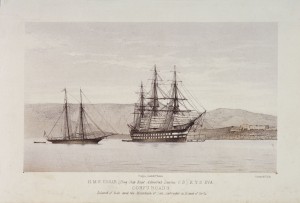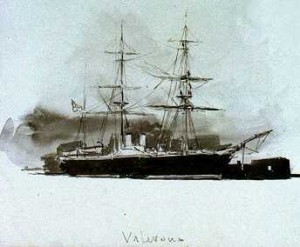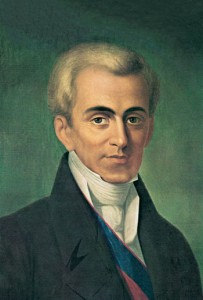
H.M.S Edgar (in which Charles Dent was the First Lieutenant) with the R.Y.S. Eva in Corfu Roads, the Island of Vido and the mountains of San Salvador in the background, by Forster
‘If I wrote a book about Corcyra it would not be a history but a poem.’ That is the promise that Lawrence Durrell fulfils in his beautiful Prospero’s Cell: A Guide to the Landscape and Manners of the Island of Corfu. First published in 1945, the book is one of the fruits of his Alexandrian exile during World War II.
Among the curiosities of the island, Durrell mentions ‘the remains of a Venetian aristocracy living in overgrown baronial mansions, buried deep in the country and surrounded by cypresses’. More curious still is Corfu’s relationship with the British, who ruled the Ionian Islands, of which it is part, for fifty years from 1814 to 1864, when they were ceded to Greece. Britain’s legacy to ‘Corcyra’ today includes, apart from some ‘nostalgic love and admiration’ (notwithstanding their resentment of them at the time), an addiction to cricket – ‘a mysterious and satisfying ritual which the islanders have refused to relinquish’ – and to ginger beer.
A blending between the decaying aristocracy of the island and its ‘bluff rulers’ – Durrell quotes Viscount Kirkwall’s description of them as exasperatingly self-satisfied with their paper-chases and tea-parties – occurred in my own family. Admiral Charles Bayley Calmady Dent, born at Plymouth in 1832, was my grandfather’s great-uncle. My grandfather was brought up by Charles’s sister. Steeped him in naval lore (the Dents had been serving continuously since the late 1600s), my grandfather himself embarked on a naval career at the age of only thirteen.

H.M.S. Valorous in 1851. Charles Dent served in her in the Baltic campaign during the war with Russia
Charles Dent’s period of service had been full of incident. The youthful First Lieutenant of H.M.S. Valorous during the war with Russia (the so-called ‘Crimean War’), he had been posted not to the Black Sea but to the Baltic, and had led a raid on the port of Uleaborg on the Gulf of Bothnia, destroying its stores and installations. The citizens of Uleaborg had already abandoned the town, leaving a ‘large number of spirit-stores open’, but Charles’s marines had maintained their discipline, despite the ‘great trials and temptations’ to which they were exposed, not to mention ‘the almost uninterrupted sleet’.
Transferring to H.M.S. Gorgon, which, like Valorous, was a paddle-steamer, Charles saw further action in the Baltic, in September 1855. In command of a detachment consisting of the pinnace, the cutter and a gig from Gorgon, together with forty of her crew, he was sent ‘to examine the Siela Sound, entrance [to the] Gulf of Riga, with directions to take possession of a small islet in that quarter; a position for stopping the trade passing in or out, as also forming a good shelter for the boats’.
In a period of five days, Charles succeeded in capturing ‘nine small vessels’ with their cargoes, and was able to report that ‘no vessel had escaped the line referred to, although the weather was rather unfavourable for boating operations’. These were actions almost worthy of Charles’s father, Rear-Admiral Charles Calmady Dent, a naval officer of the heroic age, who had assisted in assaults on Possitano and other Italian ports in the Napoleonic War, at the capture of Port d’Anzo (where there was heavy loss of life) and, later, in the boarding of a pirate vessel in the Persian Gulf, in which a misplaced thrust in the head from a boarding-pike is said to have ‘half-killed’ him.
The ‘heroic age’ was further recalled when Charles, by now a Commander, was appointed, on 11 July 1862, to the two-decker battleship H.M.S. Edgar, again as First Lieutenant. This was a time when ‘the transition from sails to steam was being gradually accomplished’. The Channel Squadron, of which she was part, consisted of ‘a mixture of wooden ships and ironclads: most of the former could not steam, none of the latter could sail. Nevertheless the Admiralty, who always have an eye to economy, decreed that, as the ships had masts and yards, they must sail.’ In the midst of all the advances in technology for which that era is famous, H.M.S. Edgar was a steamship, yet wooden-hulled and fully masted, looking exactly like something from Nelson’s fleet at Trafalgar, nearly sixty years before.
It was during a cruise of the Mediterranean in the summer of 1862 that Charles sailed in the Edgar into Corfu Harbour, to a fateful meeting with his future wife, Corinna Kourkoumelles. Born on Corfu on 21 November 1840, she was the eldest of the three daughters of Sir Demetrios Kourkoumelles, K.C.M.G., an Advocate, who served as Regent of the British Military Protectorate of Corfu from 1862 until the end of British rule in 1864, after which he became a Member of the Hellenic Parliament.
Sir Demetrios’s picturesque family seat at Afra (‘Breeze’), in the centre of the island, had been built in the 18th century in the Venetian style, above the cloisters of a deserted monastery – the family having migrated to the island from Kephalonia in the about 1750. The house at Afra is, or was until recently, still in the possession of the family (and occasionally visited by Corinnas’s descendants), but may be the old mansion there that is currently being offered for sale – http://rrcorfurealestate.com/pages/en/sales.php?prod=291&cat=5. It is just the sort of ‘overgrown baronial mansion, buried deep in the countryside and surrounded by cypresses’, to which Durrell refers.

Ioannes Kapodistrias, the Corfiot who was Greece's first President - the great-uncle of Corinna Kourkoumelles
The family had impeccable Corfiot connections. Corinna’s mother was Elisa, daughter of Nicolo Rodostamo, member of the Ionian Parliament, by his wife Maria, daughter of Count Antonio-Maria Kapodistrias, Doctor of Laws at Pavia, Member of the Grand Council of Corfu, Senator, and sometime Ambassador to the Sultan and the Tsar. Antonio-Maria was the brother of Ioannes Kapodistrias, undoubtedly Corfu’s most famous son – Minister of Foreign Affairs in the Tsar’s service (1816-22), and first President of Greece between 1827 and 1831 (when he was assassinated).
Charles and Corinna’s wedding took place in London, at Kensington Parish Church, on 6 August 1863 – the Edgar’s First Lieutenant was able to absent himself from a summer cruise around the British Isles. His address was given as 1 Norwood Place, and that of his bride as 40 St James’s Place. The then master of the Edgar was no doubt present – the future Admiral-of-the-Fleet Sir Geoffrey Phipps Hornby, a grand Victorian figure (and a connection by marriage), who was to be celebrated, at the end of a long naval career, for never having fired a shot in anger.
Corinna’s family clearly did not share the general distrust of Corfiots for the British. Her father is said to have preferred to be called ‘Sir Demetrios’ rather than ‘Count’ – the Order of St Michael and St George, to which he belonged, is nowadays doled out to diplomats and others serving overseas, but had been instituted in 1818 specifically to reward natives of the Ionian Islands and of Malta. While in England, Sir Demetrios matriculated an elaborate coat of arms at the Herald’s College which included a variant on the Dent family motto – to their Ne Cede Malis he had added Sed Contra. Corinna’s younger sister Euphrosyne was also to marry an English officer, a Major Jettars.
The newly-wed Corinna had quickly to inure herself to the prolonged absences of her husband, the Channel Squadron spending the winter of 1863-4 between Madeira, Teneriffe, Gibraltar and Lisbon. At Portland on 25 April 1864, it was to receive a visit from Garibaldi and his entourage. They were entertained to a substantial late lunch – it began at 6 p.m. – aboard the Edgar, as flagship of the commander-in-chief, Admiral Dacres.
From the middle of the following August, the headquarters of the fleet was at Portsmouth, where the ships remained until 27 March 1865, ‘when the Edgar came out of harbour under sail – the last line-of-battle ship that ever sailed out of Portsmouth Harbour’. The crew of the Edgar were no doubt unconscious at the time of their moment in history. The squadron had cruised down to Lisbon by 22 April, bearing a mission (under Lord Sefton) to invest the King of Portugal with the Order of the Garter. The ensuing festivities included a visit by the King himself to the Edgar, and a match against the Lisbon Cricket Club, in which the naval team was victorious. Perhaps Charles and others of his crew had already played a part in inculcating the Corfiots with a love of the game.
Charles never achieved a command of his own, and the Edgar was his last ship. He retired from the service on 16 December 1865, and took up a post with the London North Western Railway, as their Marine Superintendent at Holyhead on the Isle of Anglesey. He was nevertheless to enjoy promotion on the superannuated list (having commuted the pay), eventually attaining the rank of Admiral in 1893. He died at Chester on 20 March 1894. Corinna died at a cottage called ‘Decoy’, near Beaulieu, on 27 January 1918.
The product of a hard school, Charles was no doubt a tough, stoical seaman and stern disciplinarian. The log-book of one of his officers in the Edgar, G.S. Rolph, was recently sold by a dealer and offers insights into the routine of life aboard in 1864: ‘Sailmakers repairing mainsail… Carpenters variously employed’; ‘Mustered by divisions. Performed Divine Service’; ‘Punished Wm. Shipper with 36 lashes as per warrant.’ ‘Fired Royal Salute.’ (http://www.baumanrarebooks.com/rare-books/ship-s-log-ralph-george-s-/illustrated-manuscript-log-of-the-h-m-s-edgar/83728.aspx) Charles’s son Douglas Lionel Dent, who served in a successor to H.M.S. Edgar and also became an Admiral, was a notorious martinet, known in the service as ‘The Rogue Elephant’; a daughter, Cora, was the formidable Matron of the Royal Infirmary, Bristol, known as ‘The Acid Drop’. The men of the family were conspicuous for their height and build: one piece of family lore that has passed down to me is that Charles could contain Corinna’s tiny waist within the span of his hands.
(National Archives, ADM 196/13/Vol.I, p.257; Navy Lists; The Russian War, 1854: Baltic and Black Sea. Official Correspondence, ed. D. Bonner-Smith and A.C. Dewar (Navy Records Society, 1943), pp.64-5, 74-5, 79; The Russian War, 1855: Baltic. Official Correspondence, ed. D. Bonner-Smith (Navy Records Society, 1944), pp.320-3; Mihail Dimitri Sturdza, Grandes familles de Grèce, d’Albanie et de Constantinople: Dictionnaire généalogique (Paris, 1983), pp.251-2, 286; Rupert Willoughby, ‘The Naval Dents and their Marriages’, Genealogists’ Magazine, Vol.25, No.12 (Dec. 1997).)
Dear Mr Willoughby,
This is very interesting. Now I know a lot more about my family history. For my army day you can take a picture of Charles Hastings Dent and put it on your website.
Yours sincerely,
Saxon Stacey
I’ll do that! Thank you.
Dear Mr Willoughby,
I have handed in the letter/petition to Mr Thomas. We got 51 names. Some people want to sign twice. Others wrote thing like ‘stay Mr Willoughby’.
Yours sincerely,
Saxon Stacey